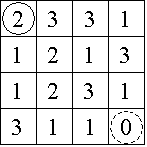HDU 1208 跳格子题(很经典,可以有很多变形)
Posted yinbiao
tags:
篇首语:本文由小常识网(cha138.com)小编为大家整理,主要介绍了HDU 1208 跳格子题(很经典,可以有很多变形)相关的知识,希望对你有一定的参考价值。
题目链接:
http://acm.hdu.edu.cn/showproblem.php?pid=1208
Pascal‘s Travels
Time Limit: 2000/1000 MS (Java/Others) Memory Limit: 65536/32768 K (Java/Others)
Total Submission(s): 2795 Accepted Submission(s): 1298
Problem Description
An n x n game board is populated with integers, one nonnegative integer per square. The goal is to travel along any legitimate path from the upper left corner to the lower right corner of the board. The integer in any one square dictates how large a step away from that location must be. If the step size would advance travel off the game board, then a step in that particular direction is forbidden. All steps must be either to the right or toward the bottom. Note that a 0 is a dead end which prevents any further progress.
Consider the 4 x 4 board shown in Figure 1, where the solid circle identifies the start position and the dashed circle identifies the target. Figure 2 shows the three paths from the start to the target, with the irrelevant numbers in each removed.

Figure 1

Figure 2
Consider the 4 x 4 board shown in Figure 1, where the solid circle identifies the start position and the dashed circle identifies the target. Figure 2 shows the three paths from the start to the target, with the irrelevant numbers in each removed.


Input
The input contains data for one to thirty boards, followed by a final line containing only the integer -1. The data for a board starts with a line containing a single positive integer n, 4 <= n <= 34, which is the number of rows in this board. This is followed by n rows of data. Each row contains n single digits, 0-9, with no spaces between them.
Output
The output consists of one line for each board, containing a single integer, which is the number of paths from the upper left corner to the lower right corner. There will be fewer than 2^63 paths for any board.
Sample Input
4
2331
1213
1231
3110
4
3332
1213
1232
2120
5
11101
01111
11111
11101
11101
-1
Sample Output
3
0
7
Brute force methods examining every path will likely exceed the allotted time limit.
64-bit integer values are available as "__int64" values using the Visual C/C++ or "long long" values
using GNU C/C++ or "int64" values using Free Pascal compilers.
Hint
Hint
Source
分析;
看到一句话:
所谓动态规划,就是每一个阶段你要做出一个决策,从最开始的决策到结束的决策的集合叫做一个策略,而各个阶段决策的多样性直接导致了策略的多样性,而我们一般求得的不是最有策略结束最大最小花费策略,每一个阶段的决策在这种有目的的作用下都与上一个阶段的决策相关,我们用记录这个阶段的一个东西(通常是动态数组)来记录这个状态符合我们需要的策略的决策
唉,还是不能很好的理解dp思想
本题分析;
要 求左上角到右下角的方法数
每次只能往下或者往右跳,跳的格子数必须等于现在站的格子的权值(不能少跳,比如你站的格子中权值是3,那么你在不超出边界的条件下你一定要跳3个格子),这样一来,有的格子可能跳不到,而有的格子可能有多种到达的方式
dp[i][j] 表示到达i,j的方法数目
注意:
1.初始化问题:dp初始化为0,dp[0][0]=1
2.状态转移方程:
dp[i][j+a[i][j]]+=dp[i][j];
dp[i+a[i][j]][j]+=dp[i][j];
不超边界的前提下(j+a[i][j]<n i+a[i][j]<n)
3.long long 类型(注意题目中拿到2的63次方)
代码如下:
#include<bits/stdc++.h>
using namespace std;
#define max_v 40
long long dp[max_v][max_v];//dp[i][j] 表示到达i行j列有多少种走法
long long a[max_v][max_v];
char s[max_v];
int main()
{
int n;
while(~scanf("%d",&n))
{
if(n==-1)
break;
getchar();
for(int i=0;i<n;i++)
{
scanf("%s",s);
for(int j=0;j<strlen(s);j++)
{
a[i][j]=s[j]-‘0‘;
}
}
memset(dp,0,sizeof(dp));
dp[0][0]=1;
for(int i=0;i<n;i++)
{
for(int j=0;j<n;j++)
{
if(a[i][j]==0)//防止死循环
continue;
if(j+a[i][j]<n)//向右边跳
{
dp[i][j+a[i][j]]+=dp[i][j];
}
if(i+a[i][j]<n)//向下跳
{
dp[i+a[i][j]][j]+=dp[i][j];
}
}
}
printf("%lld
",dp[n-1][n-1]);
}
return 0;
}
以上是关于HDU 1208 跳格子题(很经典,可以有很多变形)的主要内容,如果未能解决你的问题,请参考以下文章
BZOJ1915: [Usaco2010 Open]奶牛的跳格子游戏